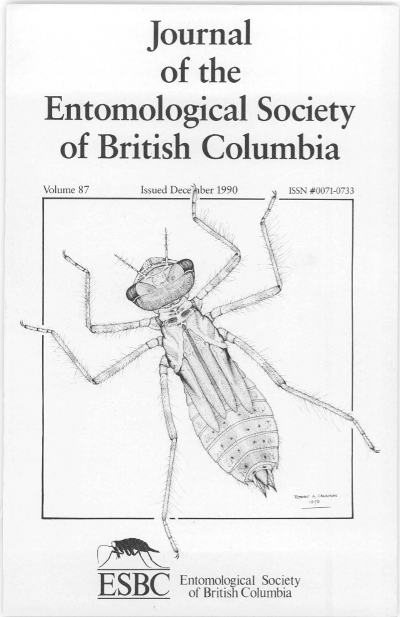Observations on the biology of the bronze flea beetle <i>Altica tombacina</i> (Coleoptera: Chrysomelidae) in British Columbia
Abstract
Populations of A. tombacina were monitored for 2 years at three field sites of varying elevation on Vancouver Island . In 1988, population densities of overwintered adults were greatest at the middle elevation (615m) followed by the highest (830m) and lowest at the low elevation (185m). Egg densities remained below 101m2 at 185m but exceeded 200/m2 in places at 615m and 400/m2 at 830m. Egg mortality was exceedingly high at all sites ranging from 98% at 185m, 95% at 615m and 99% at 830m; very few larvae appeared to survive. Only 2 adults were counted the following spring at the lowest elevation where eggs and larvae were exceedingly difficult to find . No life stages could be found at either of the higher elevation sites. Cold weather early in June, 1988, appeared to be responsible for this population decline. Overwintered adults of A. tombacina were also reared in the laboratory at constant temperatures of 18° and 25°C. The rate of oviposition was greater by a factor of 2 at the higher temperature. The egg-adult survival rate was approximately 15% at 25°C and there was no completed development at 18°. Each larva surviving to pupation consumed a mean of about 28mg. dry weight of leaf.Downloads
Issue
Section
License
Authors who publish with the Journal of the Entomological Society of British Columbia agree to the following terms:
-Authors retain copyright and grant the journal right of first publication with the work simultaneously licensed under a Creative Commons Attribution License that allows others to share the work with an acknowledgement of the work's authorship and initial publication in this journal.
-Authors are able to enter into separate, additional contractual arrangements for the non-exclusive distribution of the journal's published version of the work (e.g., post it to an institutional repository or publish it in a book), with an acknowledgement of its initial publication in this journal.
-Authors are permitted and encouraged to post their work online (e.g., in institutional repositories or on their website) prior to and during the submission process, as it can lead to productive exchanges, as well as earlier and greater citation of published work (See The Effect of Open Access).


